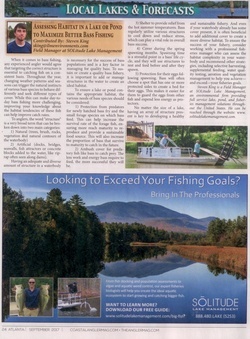Assess Fish Habitat to Maximize Better Bass Fishing
September 14th, 2017
AS SEEN IN Angler Magazine: Written by Industry Expert Steven King, Field Manager
 When it comes to bass fishing, any experienced angler would agree that targeting the correct structure is essential to catching fish on a consistent basis. Throughout the year, changing weather patterns and seasons can trigger the natural instincts of various bass species to behave differently and seek different types of cover. While this can make day-to-day bass fishing more challenging, improving your knowledge about fish habitat and tendencies can help improve catch rates.
When it comes to bass fishing, any experienced angler would agree that targeting the correct structure is essential to catching fish on a consistent basis. Throughout the year, changing weather patterns and seasons can trigger the natural instincts of various bass species to behave differently and seek different types of cover. While this can make day-to-day bass fishing more challenging, improving your knowledge about fish habitat and tendencies can help improve catch rates.
To anglers, the word “structure” is a very broad term that can be broken down into two main categories:
1) Natural fish cover (trees, brush, rocks, aquatic vegetation and natural contours of the waterbody)
2) Artificial fish cover (docks, bridges, seawalls, fish attractors or concrete blocks added to the water, like rip-rap often seen along dams).
Having an adequate and diverse amount of structure in a waterbody is necessary for the success of bass populations and is a key factor in managing for quality bass. To sustain or create a quality bass fishery it is important to add or manage structures in the water to create an ideal habitat.
To ensure a lake or pond contains the appropriate aquatic habitat, the various needs of bass species should be considered:
1) Protection from predators for newly hatched bass fry and the small forage species on which bass feed. This can help increase the survival rate of the forage fish, ensuring more reach maturity to reproduce and provide a sustainable food source. This will also increase the proportion of bass that survive to maturity to catch in the future.
2) Ambush cover for predatory fish like bass to catch prey. The less work and energy bass require to feed, the more successful they will be.
3) Shelter to provide relief from the hot summer temperatures. Bass regularly utilize various structures to cool down and reduce stress, which can play a vital role in overall bass success.
4) Cover during the spring spawning months. Spawning time is a stressful point in a bass’ life cycle and they will use structures to rest and feed before and after they spawn.
5) Protection for their eggs following spawning. Bass will often choose a spot that has one or more protected sides to create a bed for their eggs. This makes it easier for them to guard the eggs from other fish and expend less energy as protectors.
No matter the size of a lake, having an array of structure present is key to developing a healthy and sustainable fishery. And even if your waterbody already has some cover present, it is often beneficial to add additional cover to create a more diverse habitat. To ensure the success of your fishery, consider working with a professional fisheries management company that can assess the habitat complexity in your waterbody and recommend other strategies, including selective harvesting, supplemental feeding, water quality testing, aeration and vegetation management to help you achieve—and exceed—your fisheries goals.
Contact the experts at 888-480-5253 for all of your lake, pond, wetland and fisheries management needs.
 Steven King is a field manager and licensed aquatic applicator at SOLitude. Steven has extensive experience navigating and managing public waterways, and has a special interest in using his knowledge and expertise to create healthy, beautiful ecosystems for clients.
Steven King is a field manager and licensed aquatic applicator at SOLitude. Steven has extensive experience navigating and managing public waterways, and has a special interest in using his knowledge and expertise to create healthy, beautiful ecosystems for clients.
SOLitude Lake Management is committed to providing full service lake and pond management solutions that improve water quality, preserve natural resources, and reduce our environmental footprint. Our services include lake, pond and fisheries management programs, algae and aquatic weed control, mechanical harvesting, hydro-raking, installation and maintenance of fountains and aeration systems, water quality testing and restoration, bathymetry, lake vegetation studies, biological assessments, habitat assessments, invasive species management and nuisance wildlife management. Services, consulting and aquatic products are available to clients nationwide, including homeowners associations, multi-family and apartment communities, golf courses, commercial developments, ranches, private landowners, reservoirs, recreational and public lakes, municipalities, parks, and state and federal agencies. Learn more about SOLitude Lake Management and purchase products at www.solitudelakemanagement.com.










